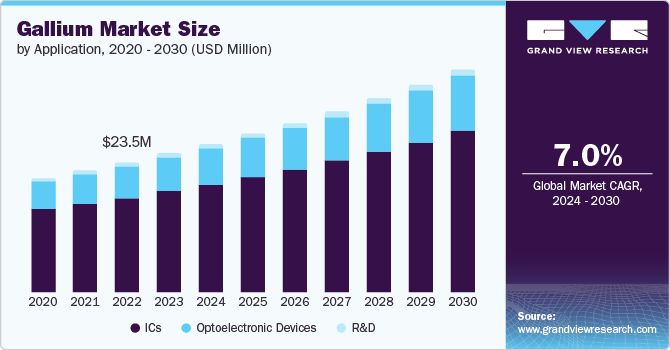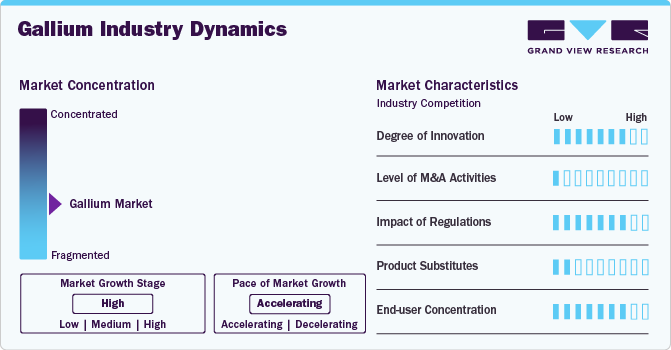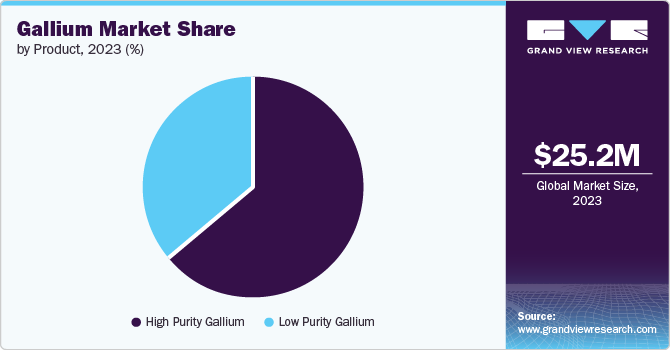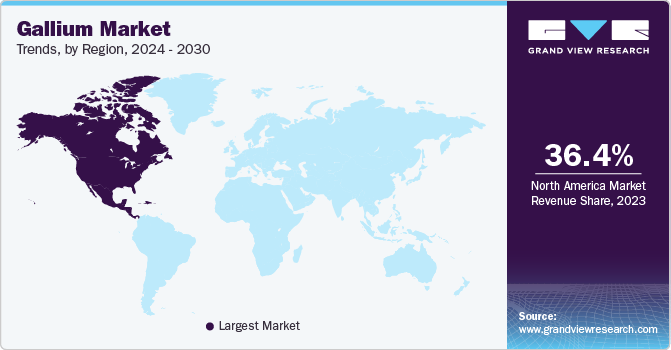
Gallium Market Size, Share & Trends Analysis Report By Product (Low Purity, High Purity), By Application (ICs, Optoelectronics), By Region, And Segment Forecasts, 2024 - 2030
- Report ID: GVR-4-68040-443-7
- Number of Report Pages: 120
- Format: PDF, Horizon Databook
- Historical Range: 2018 - 2022
- Forecast Period: 2024 - 2030
- Industry: Advanced Materials
Gallium Market Size & Trends
“2030 gallium market value to reach USD 40.4 million.”
The global gallium market size was estimated at USD 25.2 million in 2023 and is projected to grow at a CAGR of 7.0% from 2024 to 2030. The growing use of gallium (Ga)-based products is anticipated to increase owing to the rapid growth in popularity of electronic devices such as mobile phones and laptops, television transmission, light-emitting diodes (LEDs) and lighting applications, wireless infrastructure, power electronics, and satellite markets.

The growth of the market is anticipated to be largely driven by Ga usage in integrated circuits (ICs). The digital revolution in recent years, the expansion of the telecommunications industry, increasing innovations in automotive electronics, and the Internet of Things (IoT) are anticipated to drive IC demand.
Drivers, Opportunities & Restraints
The largest driver for the market growth is its usage in ICs and optoelectronic devices applications. Gallium is used in ICs as a semiconductor material, playing a crucial role in powering electronic devices. It is also used in many optoelectronic devices, including LEDs, and in powering solar cells. These are, in turn, used in various applications such as fiber optic communications and high-speed data transmission, all of which are technologies of the future.
Ga is produced during the processing of alumina from bauxite ore. It is also obtained from zinc processing activities. Several proposed bauxite mining projects present key opportunities for increasing Ga supply in the global market. For instance, the Guinea-based Koumbia bauxite project (cost of ~USD 1 billion), the Queensland-based Bauxite Hills Mine (valued at USD 30 million) by Metro Mining Limited, and the development of the bauxite-alumina mining complex in the Dakcheung region in Laos by Vietnam (investment of ~USD 1 billion) are some key projects. These are anticipated to reduce the impact of Chinese export controls on Ga and stabilize prices and supply in the global market.
A key restraint in the Ga market is the price volatility due to Chinese dominance in global supply. Even with the increase in supply by other countries, China can destabilize the market by flooding world trade with Ga exports. This can reduce prices and impact producer profitability in other countries.
Price Trends of Gallium
Ga faces an inherent threat of limited supply, with the Chinese government restricting exports of the product in June 2023. The country accounts for more than 80% of the world’s supply of Ga and, hence, is a significant factor in the pricing volatility. This resulted in an increase in prices towards the end of 2023 owing to an inventory shortage of non-Chinese supply. For instance, in December 2023, the price for low purity Ga was USD 500-600/kg, which was an increase from USD 250-265/kg, just before China’s export controls were announced earlier during the year.
Though the market remains hopeful of restrictions on Chinese export control, 2024 is likely to witness higher average prices owing to supply shortages. Moreover, the robust demand for ICs and optoelectronic devices has added to the supply glut, and this situation is likely to continue over the year.
Hence, Ga pricing has been historically influenced by various factors, and forecast prices are likely to fluctuate based on market supply and demand conditions. The key factors include trade barriers, energy costs, labor & production costs, market demand, currency exchange rates, technology advancements, environmental regulations, and the geopolitical environment. Over the historic period, global pricing trends indicated higher ranges prior to 2012, with Ga prices up to approximately USD 1,200/kg, after which China dominated the pricing and supply scenario. Following 2012, the prices of Ga decreased significantly to an average of USD 270/kg. However, post-2018, based on market demand factors, there have been instances of price volatility across regional markets.
For instance, in the U.S., the predominant application for gallium is historically attributed to ICs and optoelectronic devices. During the first half of 2023, key markets such as the U.S. witnessed a decline in demand for LEDs. This resulted in a reduction in prices, which was offset by the export bans by the Chinese, that resulted in a corresponding increase in prices over the second half of 2023.
The demand for electronic devices and new electronic technology is anticipated to increase owing to the recovery of economic activity across the world. This is anticipated to reflect upon pricing over the forecast period and can result in steady levels over the forecast period.
Market Concentration & Characteristics
The gallium market is at a high stage of industry growth, indicating an accelerated pace. Supply is concentrated in China, who have a monopoly over pricing and the global market.
The degree of innovation in technology and applications is high and is characterized by cutting-edge research that requires miniaturization and high efficiency from modern electronic components. Currently, producers and end users of Ga metal and compounds are focused on sustainable production, wherein their objective is to achieve a low carbon footprint and incur minimal costs within a safe and accident-free production facility.

The level of M&A activities has remained low over 2023. The price volatility of Ga has resulted in varying levels of profitability amongst producers, who are now resorting to enhancing production efficiency and adopting cost optimization measures to remain competitive.
The industry has a high regulatory impact. Producers are governed by laws regarding safe working environments since Ga is highly corrosive and considered a skin irritant. Laws regarding the treatment of waste and effluents according to international standards exist within the industry.
Because of its unique properties, there are very few substitutes for the product. In many defense-related applications, gallium arsenide (GaAs)—and gallium nitride (GaN)-based ICs are used, and no effective substitutes exist in these applications. Liquid crystals made from organic compounds are used in visual displays as substitutes for LEDs. Silicon-based complementary metal-oxide semiconductor power amplifiers compete with GaAs power amplifiers in mid-tier 3G cellular handsets.
Indium phosphide components can substitute for GaAs-based infrared laser diodes in some specific-wavelength applications. Helium-neon lasers compete with GaAs in visible laser diode applications. Silicon is used as a substitute for GaAs in solar cell applications. In heterojunction bipolar transistors, GaAs is being replaced in some applications by silicon-germanium.
There is a high concentration of end users in the market. The product is extensively used in the electronics industry and R&D. It is used in defense electronics, aerospace applications, consumer goods, industrial equipment, medical equipment, power electronics, and telecommunications equipment.
Application Insights & Trends
“Optoelectronic devices are anticipated to register the fastest revenue CAGR of 7.5% over the forecast period.”
Optoelectronic devices are special semiconductor devices that can interchangeably convert light energy to electrical energy. Numerous optoelectronics applications, including those in the military, telecommunications, automatic access control systems, and medical equipment, use this technology. Examples of optoelectronic devices include LEDs, solar cells, and photodiodes. Owing to the indirect bandgap of silicon, it is not widely used in optoelectronics due to its low optical absorption and emission. Hence, its substitute, Ga, is widely used, and this trend is anticipated to continue over the forecast period.
Ga is widely used in ICs owing to its high conductivity. They are used in applications such as defense, high-performance computers, and telecommunications equipment. Ga can hence produce ICs and transistors that have high strength, faster switching speed, high thermal conductivity, and lower resistance than conventional silicon ICs. Hence, IC applications accounted for a high revenue share of the Ga market in 2023.
R&D investment in the development of new electronics technology has boosted the usage of Ga in this application. For instance, in May 2022, Singapore-based Gallium Semiconductor opened a new R&D center in Nijmegen, the Netherlands, to develop innovative technology that can power next-generation mobile communications. The company provides Radio Frequency (RF) GaN solutions for 5G mobile communications. It currently undertakes research related to product development, device design, customer application engineering, and production support to serve the European market.
Product Insights & Trends
“High purity gallium held the largest revenue share of about 64.0% in 2023.”
High-purity gallium, or refined metal, contains a minimum purity level of 99.999%- and 99.99999%-Ga. It is used in the production of GaAs, GaN, and other Ga compounds. These are further used in the production of electronic devices.

GaAs-based ICs that have been developed in recent years are primarily used in applications such as satellites, supercomputers, and defense electronics since they have higher information transmission speeds, can withstand increased radiation, and operate at higher temperatures than silicon-based ICs, widely used substitutes.
Low-purity gallium has a minimum purity level of 99.99%. It is processed along with a scrap of end-of-life ICs and optoelectronic devices to produce high-purity Ga. Low purity Ga is widely available, with China being the key producer, and is a less expensive substitute to high purity Ga that is more sought after in the market for its niche applications.
Regional Insights
“China accounted for 48.0% revenue share of the Asia Pacific market.”
In terms of revenue, North America was largest region accounting for a share of 36.4% in 2023. North America gallium market is anticipated to be driven by Ga demand in the U.S. arising from IC demand in defense electronics and telecommunication systems.

U.S. Gallium Market Trends
Owing to the high defense expenditure in the U.S., electronics demand and investment in high-end, cutting-edge technology are anticipated to drive the Ga market. In addition, according to the new "Solid State Lighting Plan", the U.S. plans to achieve a 73.7% market share in LED solid-state lighting by 2030, which is a key driver to the Ga market.
Asia Pacific Gallium Market Trends
Asia Pacific gallium market witnessed the highest demand in 2023. Growth can be attributed to the sustained production of ICs and optoelectronic devices due to contract manufacturing activity and investment in R&D.
China experienced steady growth in 2023. This can be attributed to Ga usage in power electronics, 5G technology and defense related electronics.
Europe Gallium Market Trends
Europe gallium market is anticipated to witness high growth from IC applications and investment in R&D.
The gallium market in Germany is anticipated to be driven by Ga consumption in increasing IC production and the growing optoelectronics market.
Central & South America Gallium Market Trends
Central & South America gallium market is projected to witness growth driven by Brazil owing to the consumption of low purity Ga along with end-of-life scrap for the production of optoelectronic devices.
The gallium market inBrazil is anticipated to be sustained by LED production. The country is a key exporter of fireworks to the global market. The country was traditionally an importer of LEDs; however, it now produces products locally.
Middle East & Africa Gallium Market Trends
Middle East & Africa is anticipated to be sustained by the production of optoelectronic devices and investment in R&D.
Key Gallium Company Insights
Some of the key players operating in the market include Basstech International and Solvay.
-
U.S.-based American Elements was founded in 1997 in California and currently has research and production facilities in Utah, Mexico, China, and the UK. It is a manufacturer of advanced materials such as Ga for bulk industrial usage as well
-
U.S.-based Indium Corporation was established in 1996 and is headquartered in New York. It is a manufacturer of advanced electronics assembly materials solutions. The company provides Ga based solutions for the electric vehicle market, medical equipment, fire suppression, transportation, defense, and emergency communication devices.
Key Gallium Companies:
The following are the leading companies in the gallium market. These companies collectively hold the largest market share and dictate industry trends
- American Elements
- NEO
- NICHIA
- Noah Chemicals Corporation
- Reade Advanced Materials
Recent Developments
-
In May 2024, U.S.-based Guerrilla RF finalized the acquisition of Singapore-based Gallium Semiconductor to own assets of the latter’s GaN power amplifiers and front-end modules. Hence, Guerilla aims to strengthen its presence in areas of wireless infrastructure, military, and satellite communications applications.
-
In March 2023, Germany-based Infineon Technologies AG announced that they would acquire Canada-based GaN Systems for a transaction value of USD 830 million. This deal will significantly strengthen the former’s presence in the GaN end-use market.
Gallium Market Report Scope
|
Report Attribute |
Details |
|
Market size value in 2024 |
USD 26.9 million |
|
Revenue forecast in 2030 |
USD 40.4 million |
|
Growth rate |
CAGR of 7.0% from 2024 to 2030 |
|
Base year for estimation |
2023 |
|
Historical data |
2018 - 2022 |
|
Forecast period |
2024 - 2030 |
|
Quantitative Units |
Volume in tons, revenue in USD million, and CAGR from 2024 to 2030 |
|
Report coverage |
Volume & revenue forecast, competitive landscape, growth factors, and trends |
|
Segments covered |
Product, application, region |
|
Regional scope |
North America, Europe, Asia Pacific, Central & South Africa, Middle East, Africa |
|
Country scope |
U.S., Canada, Mexico, Germany, UK, France, Italy, Russia, Turkey, China, India, Japan, South Korea, Brazil |
|
Key companies profiled |
American Elements, NEO, NICHIA, Noah Chemicals Corporation, Reade Advanced Materials |
|
Customization scope |
Free report customization (equivalent up to 8 analysts working days) with purchase. Addition or alteration to country, regional & segment scope. |
|
Pricing and purchase options |
Avail customized purchase options to meet your exact research needs. Explore purchase options |
Global Gallium Market Report Segmentation
This report forecasts revenue and volume growth at global, country, and regional levels and provides an analysis of the latest trends in each of the sub-segments from 2018 to 2030. For this study, Grand View Research has segmented the global gallium market report based on product, application, and region.

-
Product Outlook (Volume, Tons; Revenue, USD Million, 2018 - 2030)
-
Low Purity Gallium
-
High Purity Gallium
-
-
Application Outlook (Volume, Tons; Revenue, USD Million, 2018 - 2030)
-
ICs
-
Optoelectronic Devices
-
R&D
-
-
Regional Outlook (Volume, Tons; Revenue, USD Million, 2018 - 2030)
-
North America
-
U.S.
-
Canada
-
Mexico
-
-
Europe
-
Germany
-
UK
-
France
-
Italy
-
Turkey
-
Russia
-
-
Asia Pacific
-
China
-
India
-
Japan
-
South Korea
-
-
Central & South America
-
Brazil
-
-
Middle East & Africa
-
Frequently Asked Questions About This Report
b. The global gallium market size was estimated at USD 25.2 million in 2023 and is expected to reach USD 26.9 million in 2024.
b. The global gallium market is expected to grow at a compound annual growth rate of 7.0% from 2024 to 2030 to reach USD 40.4 million by 2030.
b. By application, low purity gallium accounted for the largest revenue share of about 73.0% in 2023 owing to its usage in the production of ICs and optoelectronic devices.
b. Some of the key players of the global gallium market are American Elements, NEO, NICHIA, Noah Chemicals Corporation, Reade Advanced Materials, amongst others.
b. The key factors driving the growth of the global gallium market are the increasing demand for electronics applications such as smartphones, laptops, television transmission, wireless infrastructure, power electronics and satellite markets.
We are committed towards customer satisfaction, and quality service.
"The quality of research they have done for us has been excellent."




